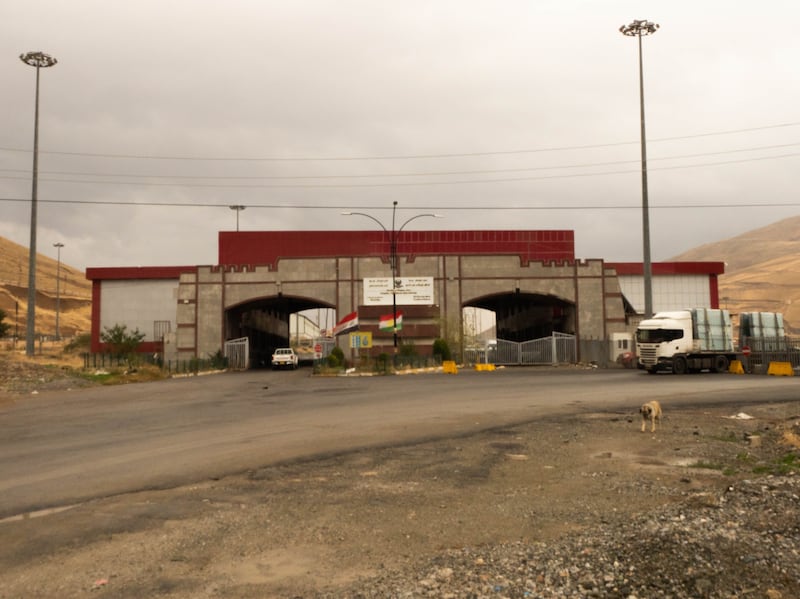The people in the bus were not afraid. They had just come from Iran, crossing the Zagros mountains into Iraqi Kurdistan. On the khaki and mustard slopes, positioned on the distinctive zigzag ridges marking the boundaries between the two countries, Iranian border forces kept watch from their lookout post.
The Irish Times boarded the mud-splattered bus just after it cleared Iraqi Kurdish customs. Mohammed (34), the driver, waved us in, eager to talk about the protests that have rocked Iran since the death in custody of Mahsa “Zhina” Amini in September. Not long before, tens of thousands had taken to the streets to mark 40 days of mourning.
According to news reports, security forces, who have reportedly attacked protesters with live ammunition, metal pellets and birdshot, had opened fire in several cities, such as Tehran, Shiraz and Saqqez. For Mohammed, it was the bloodiest day yet in his hometown of Mahabad. This time, he told us, some locals had fought back with AK47s and shotguns. “With so many killed, there will be more fighting,” he said. “People will not forget their dead relatives.”
In common with other interviewees for this article, he asked that his real name be withheld for fear of repercussions for family members in Iran.
Two women sat on the front row, a 65-year-old, swathed in black, and her smartly dressed government employee daughter, on a short trip away. They looked on – silent but smiling. “God knows how long it will take to end this regime. We just have to hope for safety. It will not be peaceful,” said the mother at last, her daughter throwing her a warning look. “I remember nothing, I know nothing,” said the mother, with a knowing smile.
Further down the road, The Irish Times flagged down another bus. A doll’s head with long hair hung from the rearview mirror, symbolic of Amini’s arrest by morality police for wearing her headscarf in a way that revealed her hair. “Mahsa Amini!” said Karokh, the 47-year-old driver, who hailed from Piranshahr, close to the border. “One hair on the head of a woman is worth more than the entire regime!”
According to rights groups, nearly 300 protesters have been killed by security forces in the ongoing crackdown. “It’s shoot to kill,” said Ali (38), taking a seat at the front. But, he added, there were people in the army who were repulsed by the orders and seemed ready to join the people. “There are soldiers who are not happy, but they can’t say anything.”
“They’re afraid it won’t last and the government will remain,” said Karokh. “If they think there’s a chance the government might fall, they will join.”
Rights groups have accused the regime of covering up the deadly crackdown, with families of the dead forced to make statements deflecting blame from the government. It was well known in Piranshahr, said Karokh, that families collecting their relatives at the morgue had been coerced into signing papers testifying that they had been killed by completely different causes. Otherwise, they would not be allowed to take their loved ones away.
People in Iran were upset and tired, he said. After hundreds of deaths and thousands of arrests, they felt abandoned by the international community. “Where are the human rights the international community talks about all the time?” he said. “They’re closing their eyes and ears. They don’t care. But they must pressurise the Iranian government.”

Abdulla, in his 60s, also from Piranshahr, joined the conversation. History was repeating itself, he said. The Iranian Revolution, which culminated in the overthrow of Shah Reza Pahlavi in 1979, saw massive confrontations between protesters and security forces, though, as he pointed out, Ayatollah Khomeini’s subsequent crushing of revolts and purges of opponents was even deadlier. “We need the people to move and take down this government,” he said.
Protests have continued in defiance of an official ultimatum. The theocratic regime has stepped up its efforts to crush the protests, announcing public trials of about 1,000 protesters, to be held in a so-called revolutionary court.
Stepping off the bus at the next village, The Irish Times met a young man standing outside a low concrete hut, watching videos of the protests on his mobile phone. After a few months working in Iraqi Kurdistan, he was planning to return home to Piranshahr the next day.
Unlike his compatriots in the buses, he had watched events unfold from the outside. He’d recently heard his 17-year-old neighbour, a childhood friend, had been killed. Asked how he felt about the regime, a look of terror came over him.
“It’s a mess, it’s chaos,” he said at last. “Iran’s intelligence services are very scary. If you get arrested, you won’t be seen ever again. The police are killing people out in the open.
“I’m hoping it will be the end of them.”









